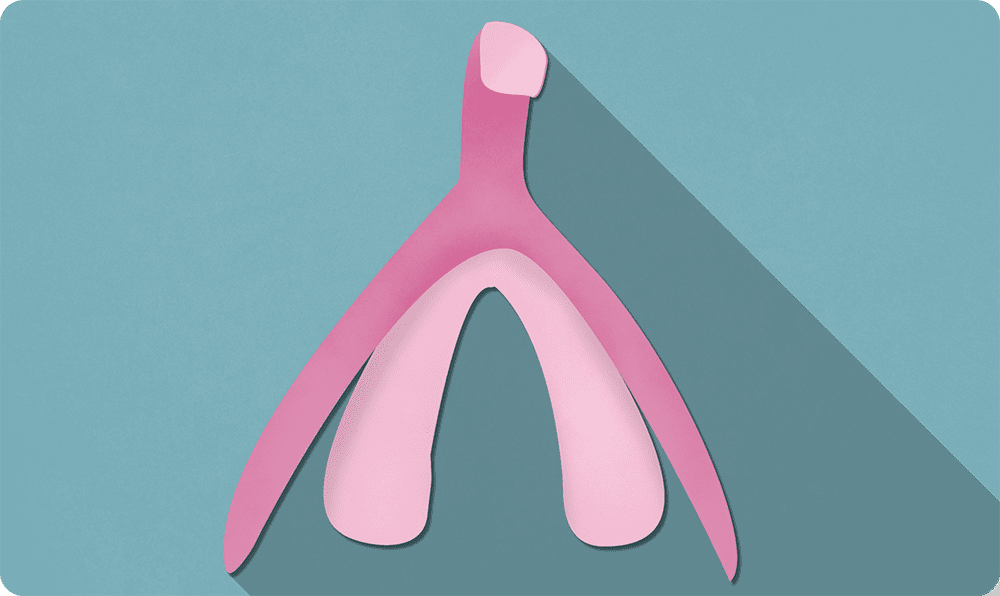
Despite more or less half the population having one, many people know very little about the vagina and there are many myths. The vagina has many interesting features that not many are aware of. Join us and get to know the vagina a bit better. Learning about your body is important and the more you know, the more you will understand your body!
Here we list 10 facts you definitely want to tell your friends!

Discharge makes many women uncomfortable, but it is completely normal. Healthy vaginal discharge consists of fluid from the vaginal walls and mucus from the cervix. That the vagina and its discharge smell is very common and usually nothing to worry about. This is often caused by helpful bacteria in the vagina - lactobacilli.
These bacteria produce lactic acid and are the same type of bacteria used in yogurt, sourdough bread, and even in beer. The bacteria are part of the vagina's natural defense and help fight fungal and bacterial infections. During the menstrual cycle, the vaginal discharge may smell slightly “metallic”.
Douching is not recommended as this can damage the natural pH balance of the vagina and dry out the mucous membranes. Soap can also damage the vagina's natural balance and most of the time, it is more than enough to wash with warm water to clean. The rest is taken care of by the vagina itself! Clever, isn't it?
Our body is host to about 100 trillion good bacteria that are crucial for our survival. These are good bacteria that live in symbiosis with us. The vagina is fantastic in many ways and is filled with good bacteria that protect the vagina and help maintain a healthy hygiene.
The most common and perhaps most important bacterium in the vagina is the aforementioned lactobacilli. This type of bacterium produces lactic acid and is the vagina's personal bodyguard against foreign infections.
All bodies are different and some orgasm easier than others. But did you know that a whole 80% of those with a vagina cannot come from penetration alone? You read right! The vast majority cannot reach climax by penetration. Several studies show that the majority need to have their clitoris stimulated to have an orgasm, which is why air pressure vibrators are so popular. Having good orgasms is important to properly build up the desire. A good trick is to use the body's erogenous zones, which we of course have created a cheat sheet for!
The woman's vagina has an average depth of 9 cm when not aroused. In the same way as a penis grows during arousal, the woman's vagina gets deeper when aroused. In connection with becoming aroused, the cervix and uterus are lifted. This deepens the vagina. When the woman is aroused, the depth of the vagina tends to expand to an average depth of about 12 cm.
When a woman becomes sexually aroused, blood flows down to the genitals and the clitoris. This makes the clitoris swell up. In addition, the clitoris becomes more sensitive and touching becomes much nicer. When you have an orgasm, the clitoris quickly returns to its original size. If there is no orgasm, however, it can take up to a day before the clitoris returns to its normal size.

The visible part of the clitoris is actually not the whole organ, but only the glans. The internal part of the clitoris is large. The inner part of the clitoris is also sensitive to sexual stimulation. There is a cluster of nerves and various erogenous zones that can be stimulated from inside the vagina. When you stimulate the G-spot, you are technically stimulating the inner parts of the clitoris.
It's a common myth that one could somehow determine if a person with a vagina has lost their virginity by checking the so-called hymen. The purpose has been to combat women's sexuality, almost like a chastity belt created from unfounded fear. The word hymen makes many people think of a membrane covering the vaginal opening. According to the myth, this is supposed to tear during the first sexual intercourse and cause bleeding. If this doesn't happen, the woman is not considered a virgin according to the myth. This membrane does not exist.
What does exist, however, are mucosal folds at the edges of the vaginal opening. This is called the hymen or vaginal corona. It's not a membrane and one cannot determine someone's virginity by checking the mucosal folds.
To learn more about the myth behind the hymen and the vaginal corona, we recommend the post and video from RFSU on the subject.
Have you heard someone say that a lot of sex, or having sex with someone with a large penis, stretches the vagina? That's not the case! The vagina can stretch. This is common, for example, after childbirth or if one actively works to stretch the vagina. But sex is not enough to stretch it. The vagina is very resilient and very elastic, after intercourse, it returns to its original size. So sex alone is not enough to stretch the vagina.

Your pelvic floor muscles are directly connected to the vagina, uterus, rectum, and urethra. Therefore, the pelvic floor muscles play a vital role in vaginal health. Strengthening these muscles with pelvic floor exercises has many advantages, one of which is more intense orgasms! You read that right, a strong pelvic floor can give you stronger and more prolonged orgasms.
After childbirth, pelvic floor muscles can weaken. This can lead to incontinence problems and leakage from the urethra. The solution? Pelvic floor exercises! With the help of a pair of geisha balls or kegel balls and a simple exercise, you can strengthen your pelvic floor. Just remember 5-5-5. Find a comfortable position, maybe lie down, lubricate your geisha balls and insert them into the vagina
For best results, do your 5-5-5 exercises three times a day and improve your orgasms!
One orgasm a day keeps the doctor away! Did you know that countless studies show the positive effects of orgasm on our physical and mental well-being?
Orgasms can, among other things, help you find peace and calm in an increasingly stressful everyday life. Sex leads to increased production of the hormone oxytocin, which can reduce stress and anxiety as it counteracts the stress hormone cortisol.
Oxytocin has also been shown to improve feelings of empathy and facilitates the creation of social bonds. In addition, this empathetic boost has been shown to improve communication between lovers. Other benefits of an orgasm are improved cardiovascular ability, reduced blood pressure, and better sleep.
So get out your sex toys and make sure to orgasm at least once a day!
(Psst! A hug also increases the production of oxytocin in the body)
The product has been added to your cart